Cutting things with a hard crust, like a freshly baked loaf of bread, or squishy soft ingredients like tomatoes, can be tricky. Especially if you are a perfectionist, not getting clean cuts can be frustrating. That’s why knives with serrated edges are designed for such job.
The tooth-like indent on the edge of the knife help chefs to “saw” through ingredients. Saving time and unexpected injuries that might be done by regular blades.
If you haven’t heard the name of a serrated knife or are unfamiliar with its uses, you are at the right place. The following article will discuss everything, from the basic definition to the types, and the uses of a serrated knife.
So, let’s begin!
Table of contents
What is a serrated knife?
If you have a set of kitchen knives you would have surely come across a serrated knife.
A serrated knife has small ridges or a tooth-like appearance on its blade. These ridges not only minimize the pressure while cutting but also pierce the crust to provide a clean cut.
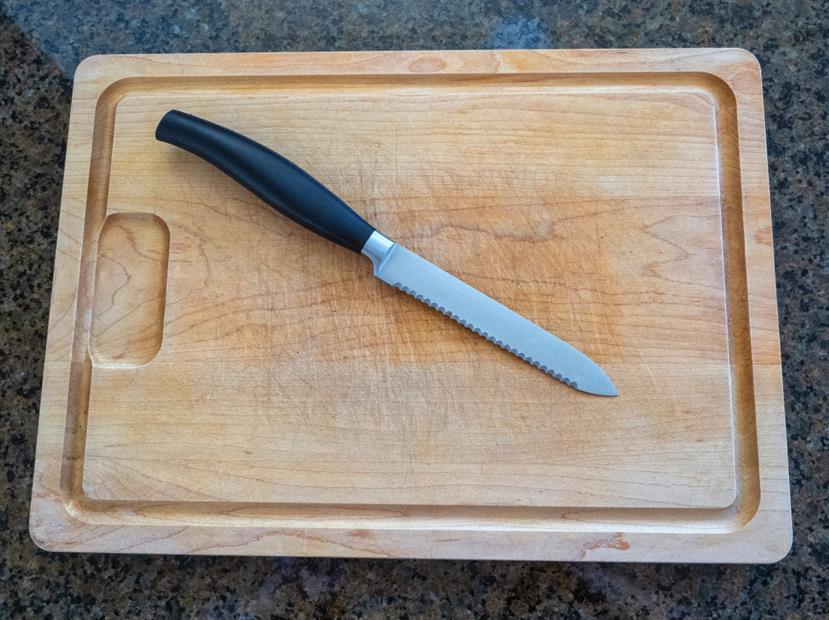
The serrations may vary in appearance. They can be saw-like, scalloped, micro, wavy, or a combination of these. Some knife manufacturers also customize and patent the serration for improved cutting of foods.
What are some of the common types of serrated knives?
Different types of serrated knives are available in the market. Each variation is specific for cutting a certain type of food. Some of the most common serrated knives include:
Flat knives
As the name states, these knives have a flat edge. This is the most commonly found serrated knife. Flat knives are commonly known as bread knives and are used to cut bread and bagels, pizza, and cakes.
The sharp serration helps to pierce the hard crust and cleanly cut the soft parts. A flat serrated knife is usually 20 to 35 cm long, however, a 25 cm long knife is of most use.
A good bread knife has an offset handle to prevent your knuckles from hitting the cutting board and is designed to produce fewer crumbs.
Flat Knives are uni-taskers i.e. they are only good for cutting bread. This can be a drawback sometimes.
Another major downside to these knives is that most flat knives provide minimal knuckle clearance.
Curved knives
If you are looking for versatility, look for a serrated knife with a curved blade. The curve in the blade provides knuckle clearance and allows you to cut in a rocking motion.
Curved serrated knives are equally efficient for cutting bread, fruits, and vegetables.
Offset knives
Offset serrated knives generally have a 6-9 cm long blade that extends 1-2 cm below the handle.
Although the unique design helps with the knuckle clearance, the smaller blade length does not give efficient control while cutting.
Other serrated variations
Fork-end Tomato knives
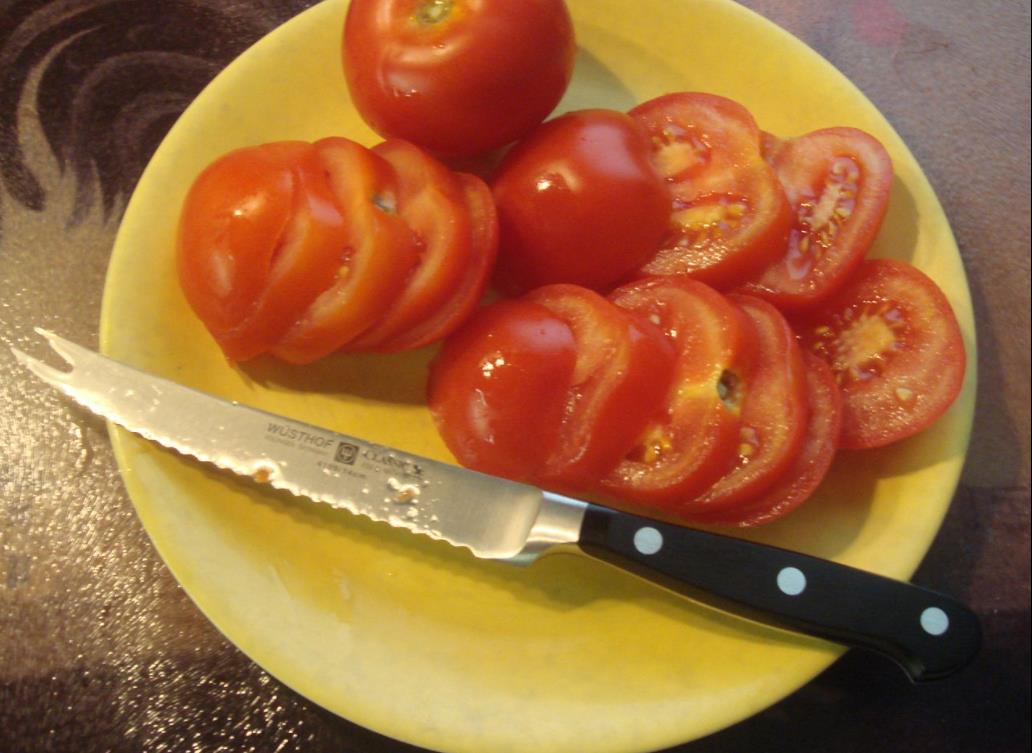
Cutting tomatoes without squishing them can be a real struggle. With a tomato knife, this won’t be the case.
These serrated knives have a fork-end which helps in picking up the thin slices after you are done cutting your tomatoes. Tomato knives are mostly 15 to 20 cm in length. The sharp serrations allow you to cut right through without squeezing the juice out.
Carving knives
Carving knives are the serrated meat slicers that will help you slice off your Christmas turkey in no time.
These knives have longer blades and a long handle to give you enough grip and control required for cutting meat.
Steak knives
Ever struggled with a well-done steak? Slicing overcooked, thick loaves of meat is a joke for these knives.
A good and sharpened steak knife can cut all sorts of meat, whether turkey or beef / rare or well done. A steak knife generally has micro serrations to provide grip and clean cuts.
Do serrated knives come in different serrations?
Yes! Not all knives have the same type of serration. They can vary in style and placement.
Serrated knives are available in two different styles, i.e.:
Pointed
A knife with pointed serration has deep, pointed teeth-like ridges on its blade.
Pointed serration is the most common serration and is efficient in cutting through fruits, vegetables, and bread.
However, a knife with pointed serrations may tear the bread loaf if not selected properly.
Tips & tricks: Prefer broadly spaced pointed serrations when buying a serrated knife. The space allows you to slice neatly without tearing apart the edible.
Scalloped
This is a more rounded type of serration. Scalloped serrations are good for slicing meat.
The crescent-shaped teeth expose the angled blade to the food. The sharp edges bite into the crust, ensuring maximum grip.
These indentations, however, are not as efficient in cutting hard crusts as the pointed ones.
Apart from these types, serrations can also be defined according to their placement:
Single edge serration
If one edge of the blade is flat and the other has serrations on it, we call it the single edge serration.
Single edge serrations are generally etched on quality bread and tomato knives.
These knives can be sharpened if required. However, if the knife is old or is sharpened too often, the serrations may diminish over time.
In this case, you can either replace the knife or ask any local knife workman/manufacturer to turn it into a plain edge knife.
Double edge serration
A double edge serration is when both sides of the blade have teeth like ridges on them.
Generally, a double-edged serrated knife has different types of serration on each side of the blade.
These knives are often cheaper, are not the best quality, and are very hard to sharpen.
Micro serration
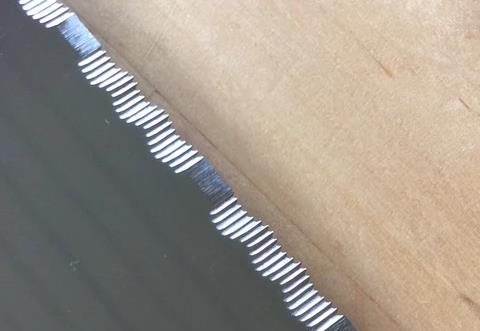
Micro serrations are very small serrations that are not designed to be sharpened.
Some bread knives or steak knives can have micro serrations on them.
Why do I need a serrated knife for my kitchen?
If you’ve only used plain-edged knives, you might get double-minded when buying a serrated knife. Your doubt is justified because chef knives are versatile and with their sharp edges they can chop off anything.
The difference lies in the force. Chef knives are designed for forceful cutting. Whereas, a quality serrated knife with its sharp-edged serrations will save the hard work for you.
Similarly, a chef knife can squish soft fruits and veggies with tough skin. On the other hand, a serrated knife will pierce the skin while keeping the soft inside intact.
Apart from this, serrated knives also provide edge retention, i.e. you don’t need to sharpen them now and then. This is because serrated knives are designed in a way that while cutting, the chiseled grind of the serrations does not come in contact with the food.
What should I look for when buying a serrated knife?
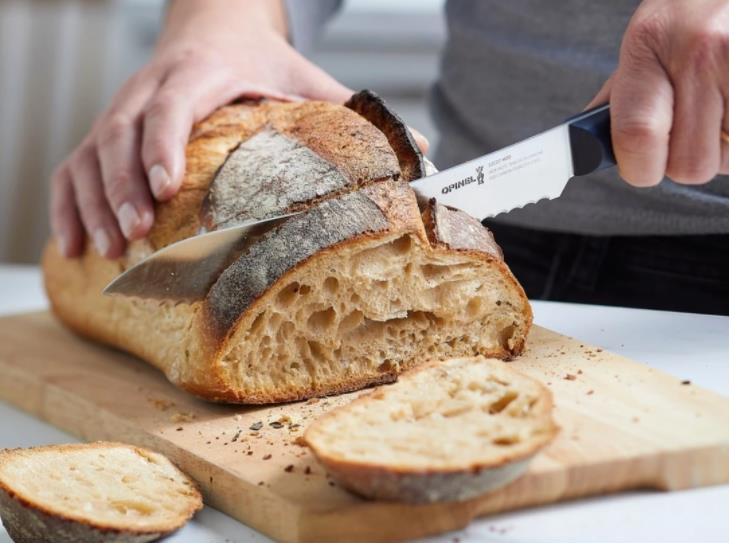
If you are out on a shopping spree and are interested in buying a serrated knife, make sure to keep in mind these points:
Blade length
Serrated knives are available in a variety of blade lengths ranging from 6 to 10 cm. You may choose the blade length depending upon the kind of food that you have to cut.
For bigger items such as watermelons, a 9cm knife would be a good option.
Blade shape
Depending upon the shape a knife can either be flat, curved or offset.
The shape can affect the efficiency of the knife and its ability to provide knuckle clearance. For instance, offset knives have good knuckle clearance but offer lesser control.
Blade thickness
Blade thickness is another key feature that determines how efficiently a knife will do its job.
Food editors have observed that serrated knives with thinner blades are more efficient than those with thicker blades.
A thin but sturdy blade helps in clean slicing and minimizes crumbling. Thicker blades sway to one side while cutting and result in uneven slices.
Tips & tricks: The most effective blades are thinner with 16 degrees edge angles.
Serrated edge
The serrated edge of the knife can be pointed or scalloped and are efficient for different types of foods.
The serrations need to be moderately sized and spaced to ensure maximum efficiency.
Handle
Buy a knife that has a firm handle. An ergonomic design will give you the perfect grip and strength to slice through bigger loaves of bread.
Don’t go for hefty ones, rather prefer the handles that feel comfortable in hand. Quality knife handles are not slippery even when wet.
Tips & tricks: Look for a knife with a sloped bolster to ensure a secure grip.
Cost
Last but not the least, look for a pocket-friendly serrated knife, but never go for cheaper alternatives.
A high-quality serrated knife is durable and stays sharp for a long period.
What is a serrated knife used for?
A serrated knife can lend you a helping hand in the following ways:
- They are the perfect match for your bread. All that a freshly baked, crusty loaf of bread needs is a quality serrated knife.
- Serrated knives are your loyal partners when it comes to cutting squishy tomatoes, hard crust watermelons, waxy kiwis, and citrus fruits.
- Evenly slice your cold pastry dough with the fear of crumbling it up, using your serrated knife.
- Serrated knives are the right tool to evenly slice and distribute a moist cake.
Whether it’s the Thanksgiving turkey or a special dinner steak, use your serrated knife and dig in right away!
How to use a serrated knife properly?
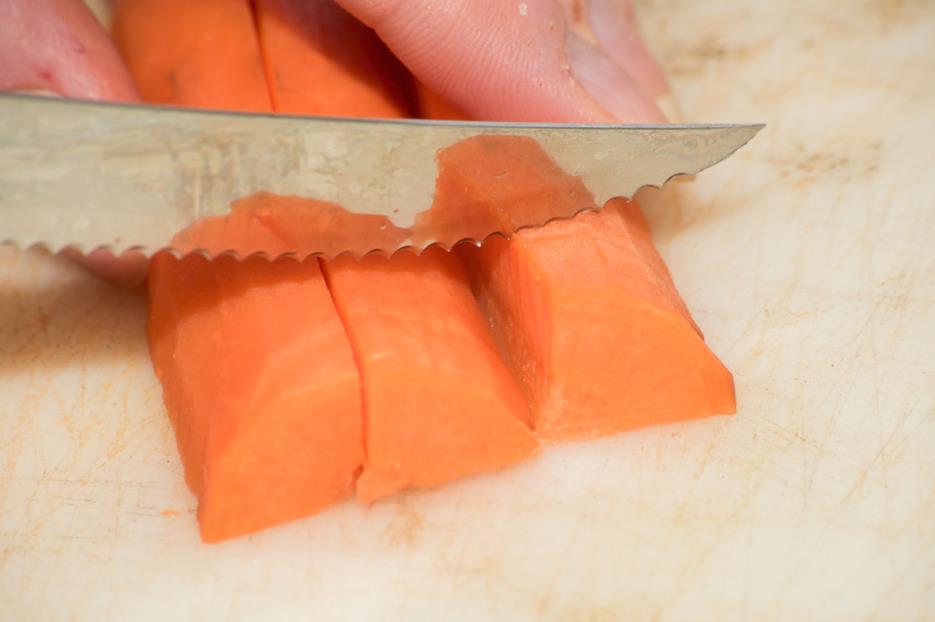
Using a serrated knife is no rocket science and home cooks can use it as efficiently as professionals.
However, cutting clean slices can be tricky for newbies. Hence practice is the key to perfection.
Let’s chalk out an example, of cutting a bread loaf, for a better understanding:
- First things first! Make sure you have a sharp knife and a clean board (wooden cutting boards are preferred for bread knives).
- Place the loaf of bread on the board and hold it firmly with your non-dominant hand.
- Make sure you keep this hand away from the knife to avoid injury.
- Now hold the serrated knife in your dominant hand, firmly curling your fingers on the handle, just below the blade.
- Place the knife on the loaf but don’t press too hard and let the serrations pierce the crust for you.
- Once you’ve dug in, move the knife to and fro to make slices.
- Make sure to use the entire blade length to make the process swift.
How to properly care for a serrated knife?
Serrated knives are not a very high-maintenance kitchen tool. Caring for your serrated knives include:
Regular cleaning
Clean your knife after every use to prolong its life and efficiency. Washing your knives (serrated or plain) in a dishwasher is never a good idea.
Instead, hand wash your knives using a mild soap and dry them immediately. Prolonged exposure to water can loosen the handles of your knife.
Safe storage
Never put your knives lose in a drawer. It is not only harmful to you but can also dull the blade edges.
Use a knife block or a magnetic knife holder to store your knives.
Sharpening
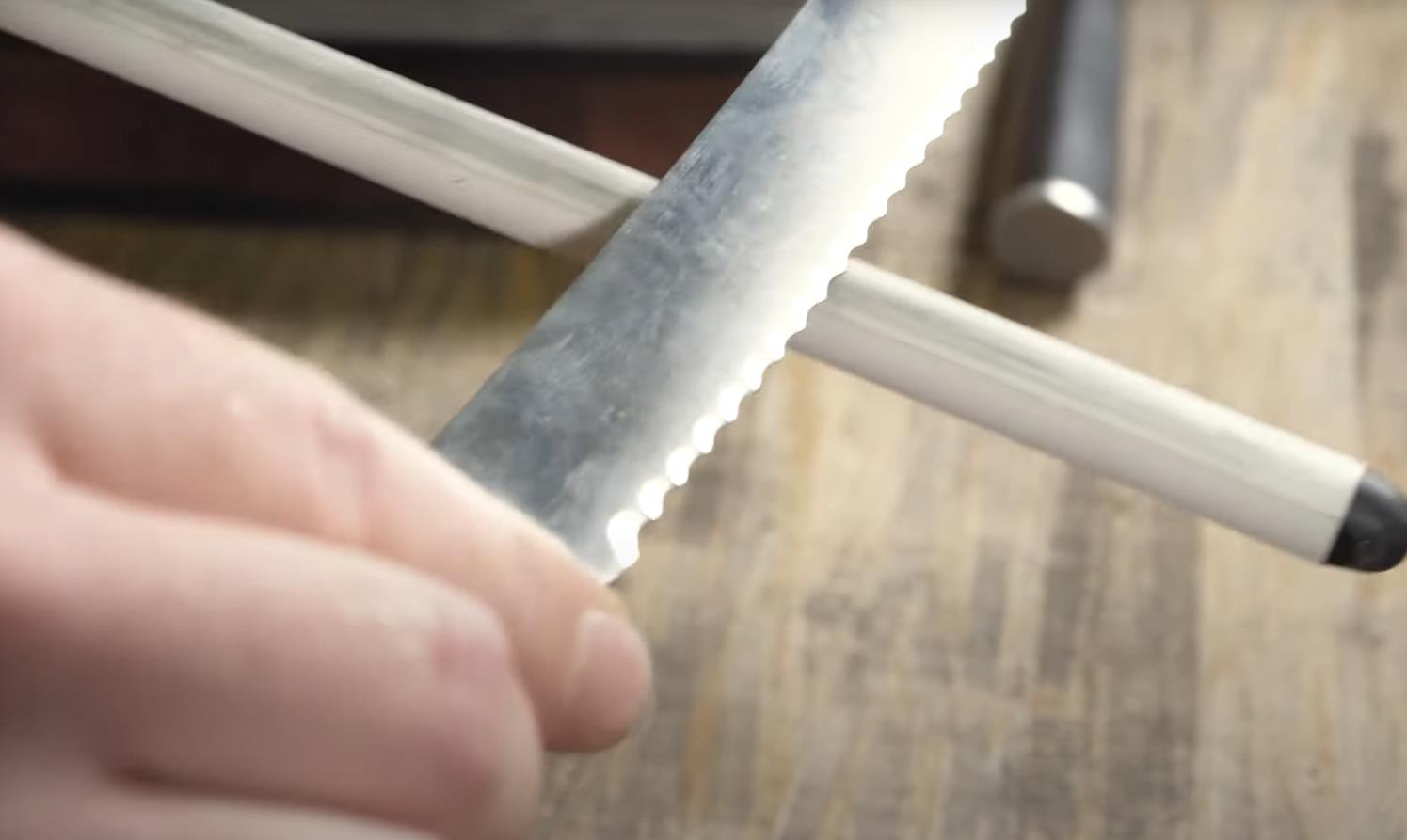
Serrated knives (unlike other knives) don’t require frequent sharpening. Their blades are designed in a way that you may need to sharpen your knife only after using it for several years. Some knife manufacturers offer free knife sharpening services. Otherwise, you can either use a sharpening rod or an electric sharpening tool for your knives.
In the case of a honing rod, you have to sharpen your knife’s blade, tooth by tooth. Electric sharpeners are a good option but first, check if your sharpener has a slot available for serrated knives.
However, it is recommended that you take it to a professional instead of trying to do it at home.
Tips & tricks: You will know it’s time to sharpen your knife when it cuts uneven slices even upon applying minimum pressure.
How to sharpen your serrated knife?
Let’s say this again, it is not safe to sharpen your knife at home if you are new to it.
Having said that, if you want to sharpen your serrated knife, below is a step-by-step tutorial:
- Hold the sharpening rod in your dominant hand, and hold the knife in the other hand with the serrations facing away from you.
- Place the sharpener in the serration you want to start with.
- Drag the rod across each serration, about 4 times each.
- Stop when the diameter of the rod matches that of the serration. Not sharpening according to the width can damage the blade.
- Keep sharpening until you start noticing burrs on the cutting edge. Burrs are the thin steel strips that scrape off during the process.
- To remove the burrs, move the rod up and down on the blade, and you are done!
Conclusion
Now that you know the uses of a high-quality, sharp serrated knife, and how to find one, we don’t know what’s stopping you from using one. Get yourself a sharp high carbon knife to complement your kitchen set.









